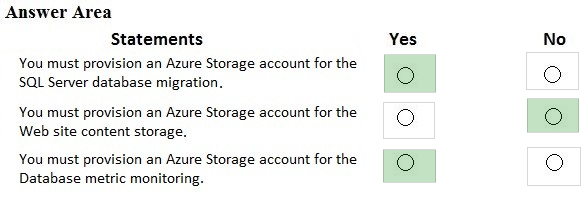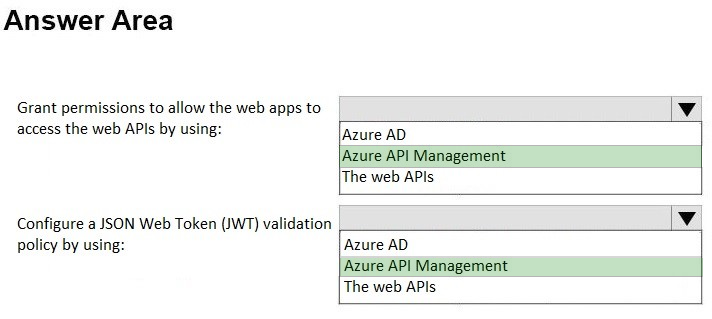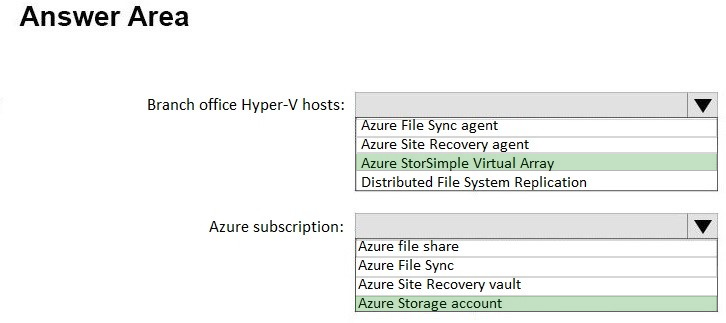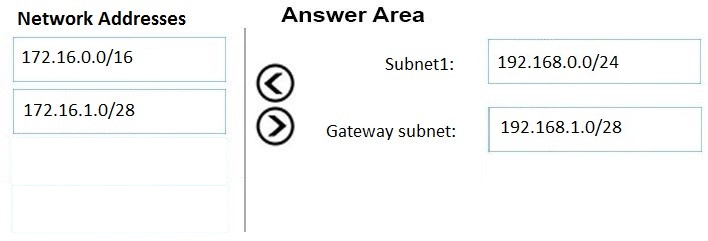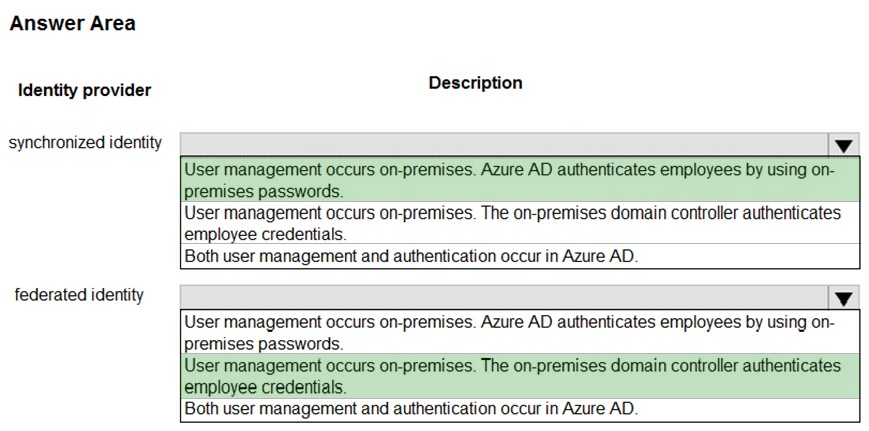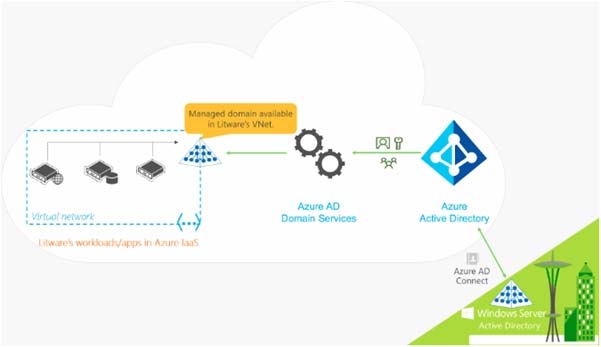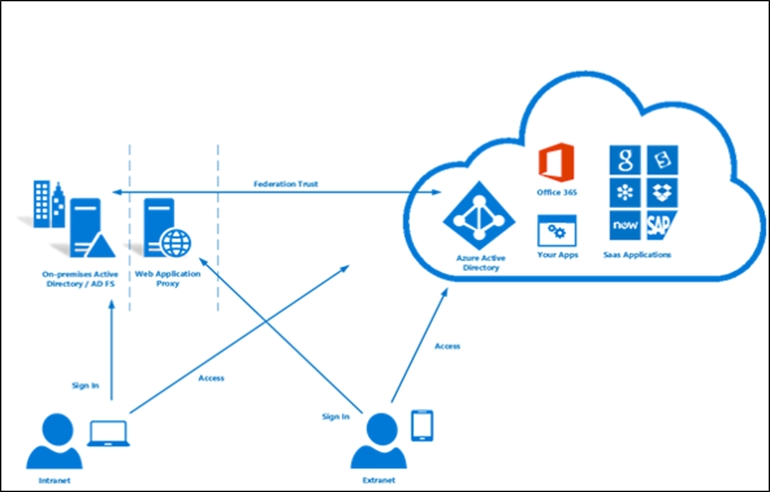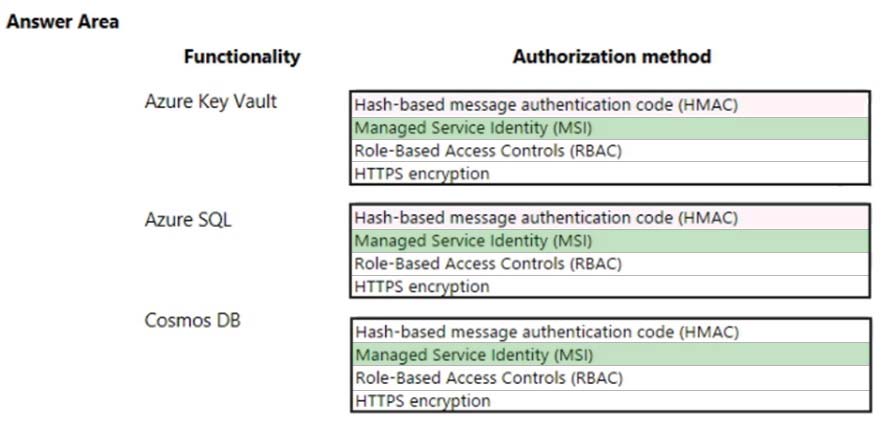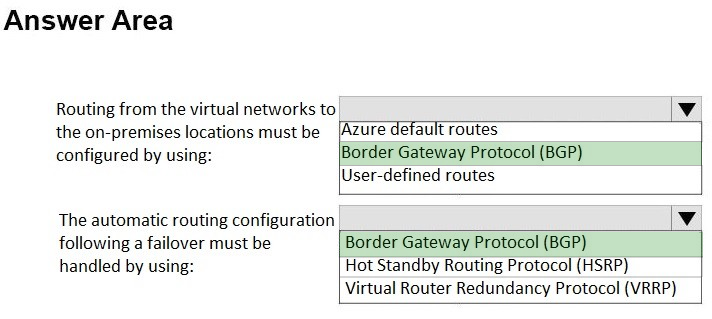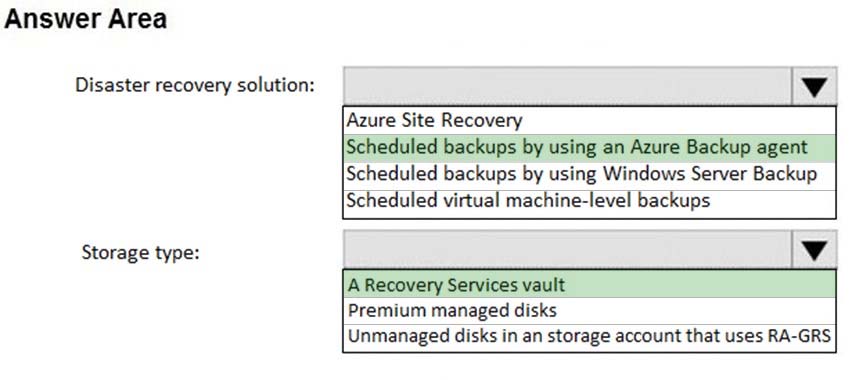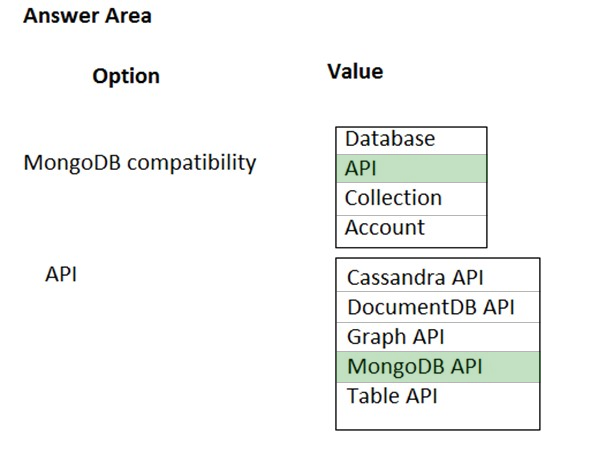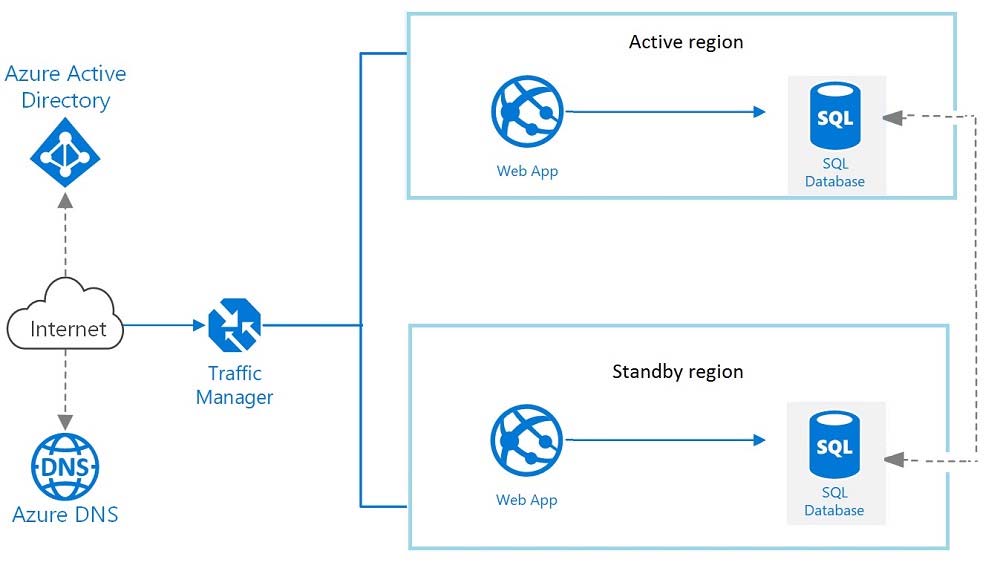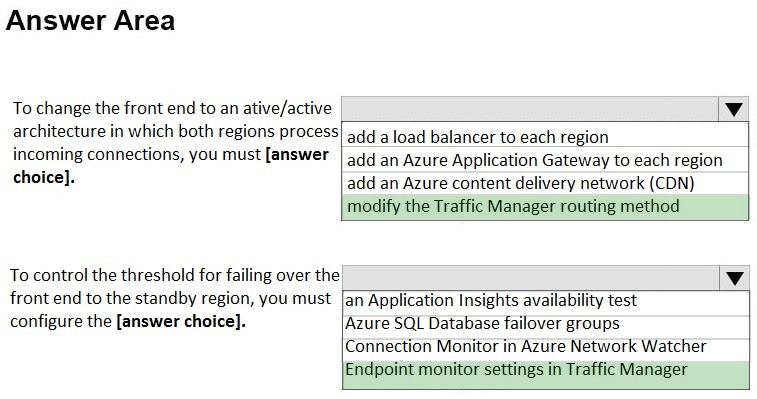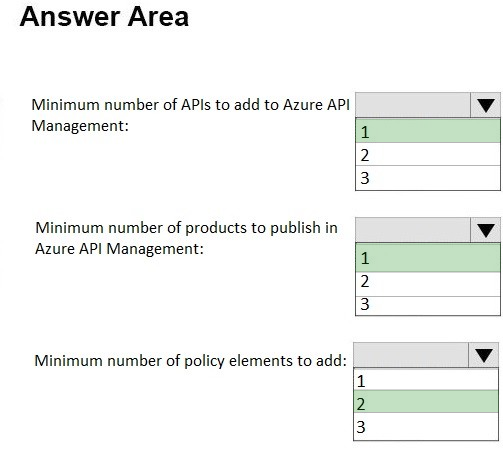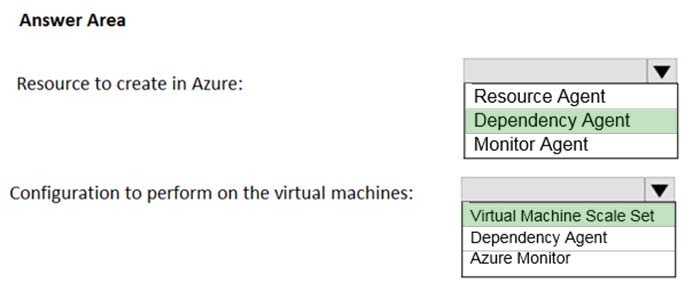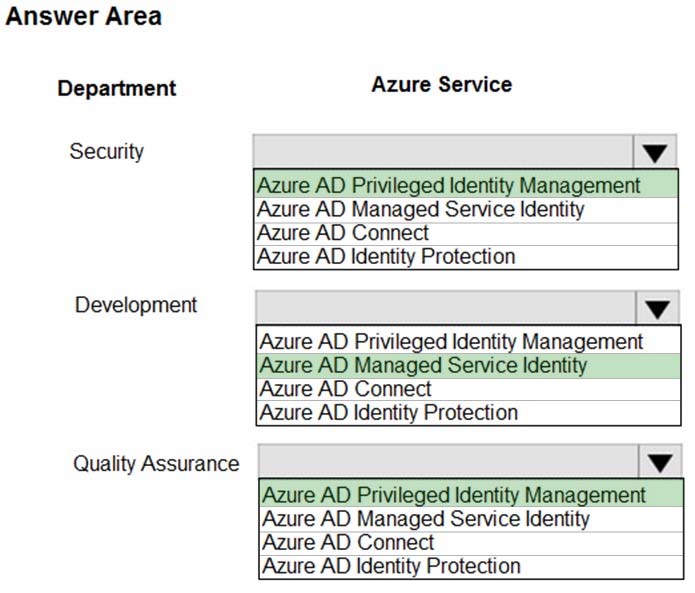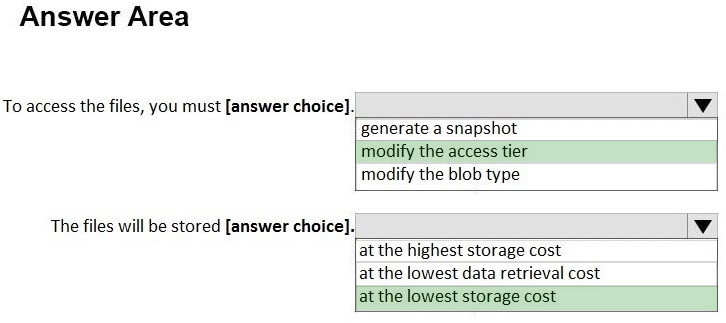AZ-301 Mock Test Free – 50 Realistic Questions to Prepare with Confidence.
Getting ready for your AZ-301 certification exam? Start your preparation the smart way with our AZ-301 Mock Test Free – a carefully crafted set of 50 realistic, exam-style questions to help you practice effectively and boost your confidence.
Using a mock test free for AZ-301 exam is one of the best ways to:
- Familiarize yourself with the actual exam format and question style
- Identify areas where you need more review
- Strengthen your time management and test-taking strategy
Below, you will find 50 free questions from our AZ-301 Mock Test Free resource. These questions are structured to reflect the real exam’s difficulty and content areas, helping you assess your readiness accurately.
You need to recommend a strategy for migrating the database content of WebApp1 to Azure.
What should you include in the recommendation?A. Use Azure Site Recovery to replicate the SQL servers to Azure
B. Use SQL Server transactional replication
C. Copy the VHD that contains the Azure SQL database files to Azure Blob storage
D. Copy the BACPAC file that contains the Azure SQL database files to Azure Blob storage
HOTSPOT -
You are evaluating the components of the migration to Azure that require you to provision an Azure Storage account.
For each of the following statements, select Yes if the statement is true. Otherwise, select No.
NOTE: Each correct selection is worth one point.
Hot Area:
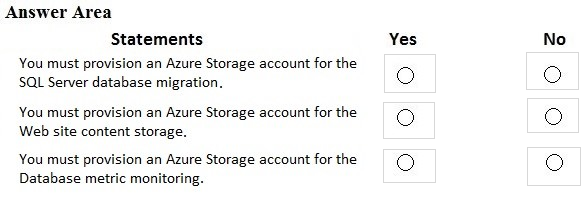
HOTSPOT -
Your company has 20 web APIs that were developed in-house.
The company is developing 10 web apps that will use the web APIs. The web apps and the APIs are registered in the company's Azure Active Directory (Azure
AD) tenant. The web APIs are published by using Azure API Management.
You need to recommend a solution to block unauthorized requests originating from the web apps from reaching the web APIs. The solution must meet the following requirements:
✑ Use Azure AD-generated claims.
✑ Minimize configuration and management effort.
What should you include in the recommendation? To answer, select the appropriate options in the answer area.
NOTE: Each correct selection is worth one point.
Hot Area:
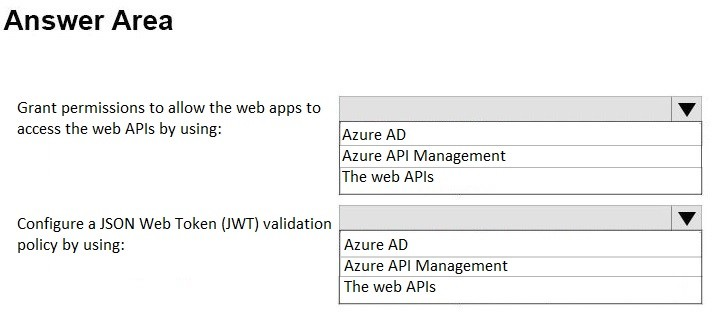
Note: This question is part of series of questions that present the same scenario. Each question in the series contains a unique solution that might meet the stated goals. Some question sets might have more than one correct solution, while others might not have a correct solution.
After you answer a question in this section, you will NOT be able to return to it. As a result, these questions will not appear in the review screen.
You need to deploy resources to host a stateless web app in an Azure subscription. The solution must meet the following requirements:
✑ Provide access to the full .NET framework.
✑ Provide redundancy if an Azure region fails.
✑ Grant administrators access to the operating system to install custom application dependencies.
Solution: You deploy a virtual machine scale set that uses autoscaling.
Does this meet the goal?A. Yes
B. No
You are designing a security solution for a company's Azure Active Directory (Azure AD). The company currently uses Azure AD Premium for all employees.
Contractors will periodically access the corporate network based on demand.
You must ensure that all employees and contractors are required to log on by using two-factor authentication. The solution must minimize costs.
You need to recommend a solution.
What should you recommend?A. Purchase Azure Multi-Factor Authentication licenses for the employees and the contractors
B. Use the Multi-Factor Authentication provider in Azure and configure the usage model for each authentication type
C. Use the Multi-Factor Authentication provider in Azure and configure the usage model for each enabled user
D. Purchase Azure Multi-Factor Authentication licenses for the contractors only
You need to recommend a strategy for the web tier of WebApp1. The solution must minimize costs.
What should you recommend?A. Configure the Scale Up settings for a web app
B. Create a runbook that resizes virtual machines automatically to a smaller size outside of business hours
C. Deploy a virtual machine scale set that scales out on a 75 percent CPU threshold
D. Configure the Scale Out settings for a web app
You have an Azure subscription that contains a custom application named Application1. Application1 was developed by an external company named Fabrikam,
Ltd. Developers at Fabrikam were assigned role-based access control (RBAC) permissions to the Application1 components. All users are licensed for the
Microsoft 365 E5 plan.
You need to recommend a solution to verify whether the Fabrikam developers still require permissions to Application1. The solution must meet the following requirements:
✑ To the manager of the developers, send a monthly email message that lists the access permissions to Application1.
✑ If the manager does not verify an access permission, automatically revoke that permission.
✑ Minimize development effort.
What should you recommend?A. In Azure Active Directory (AD) Privileged Identity Management, create a custom role assignment for the Application1 resources
B. Create an Azure Automation runbook that runs the Get-AzureADUserAppRoleAssignment cmdlet
C. Create an Azure Automation runbook that runs the Get-AzureRmRoleAssignment cmdlet
D. In Azure Active Directory (Azure AD), create an access review of Application1
HOTSPOT -
Your company has three branch offices and an Azure subscription. Each branch office contains a Hyper-V host that hosts application servers.
You need to recommend a storage solution for the branch offices. The solution must ensure that the application servers can connect to a central storage device by using iSCSI connections. Data saved to the iSCSI storage device from the application servers must be uploaded to Azure automatically.
Which components should you include in the recommendation? To answer, select the appropriate options in the answer area.
NOTE: Each correct selection is worth one point.
Hot Area:
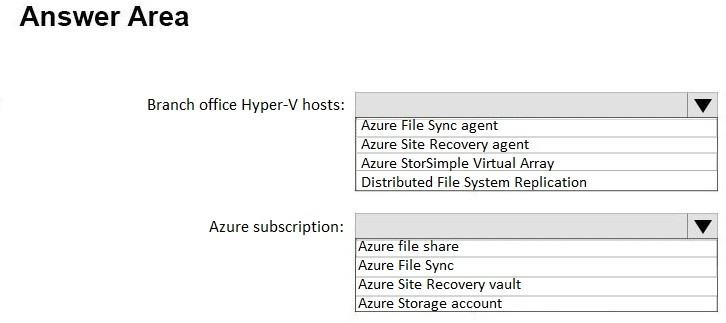
Note: This question is part of series of questions that present the same scenario. Each question in the series contains a unique solution that might meet the stated goals. Some question sets might have more than one correct solution, while others might not have a correct solution.
After you answer a question in this section, you will NOT be able to return to it. As a result, these questions will not appear in the review screen.
Your company has an on-premises Active Directory Domain Services (AD DS) domain and an established Azure Active Directory (Azure AD) environment.
Your company would like users to be automatically signed in to cloud apps when they are on their corporate desktops that are connected to the corporate network.
You need to enable single sign-on (SSO) for company users.
Solution: Configure an AD DS server in an Azure virtual machine (VM). Configure bidirectional replication.
Does the solution meet the goal?A. Yes
B. No
DRAG DROP -
You have an on-premises network that uses an IP address space of 172.16.0.0/16.
You plan to deploy 25 virtual machines to a new Azure subscription.
You identify the following technical requirements:
✑ All Azure virtual machines must be placed on the same subnet named Subnet1.
✑ All the Azure virtual machines must be able to communicate with all on-premises servers.
The servers must be able to communicate between the on-premises network and Azure by using a site-to-site VPN.
You need to recommend a subnet design that meets the technical requirements.
What should you include in the recommendation? To answer, drag the appropriate network addresses to the correct subnets. Each network address may be used once, more than once, or not at all. You may need to drag the split bar between panes or scroll to view content.
NOTE: Each correct selection is worth one point.
Select and Place:
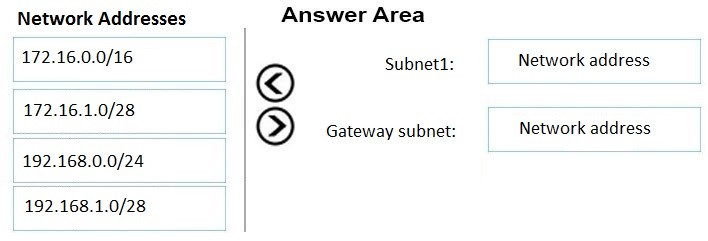
HOTSPOT -
You manage a network that includes an on-premises Active Directory Domain Services domain and an Azure Active Directory (Azure AD).
Employees are required to use different accounts when using on-premises or cloud resources. You must recommend a solution that lets employees sign in to all company resources by using a single account. The solution must implement an identity provider.
You need provide guidance on the different identity providers.
How should you describe each identity provider? To answer, select the appropriate description from each list in the answer area.
NOTE: Each correct selection is worth one point.
Hot Area:
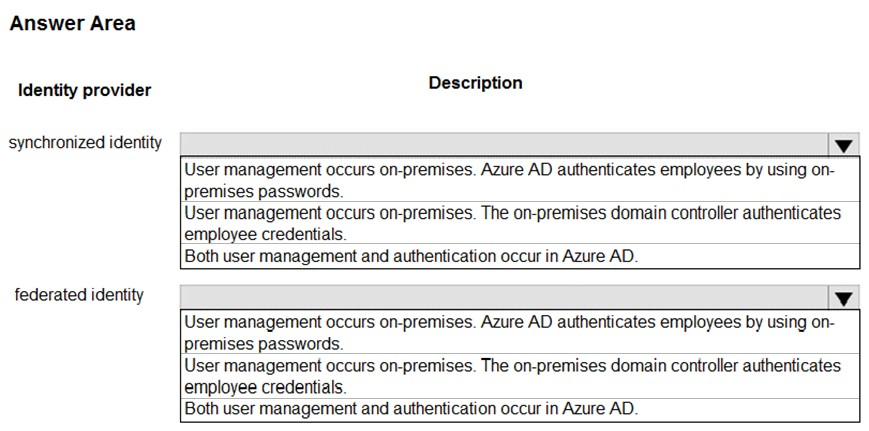
You need to recommend a solution to generate a monthly report of all the new Azure Resource Manager resource deployments in your subscription.
What should you include in the recommendation?A. the Change Tracking management solution
B. Azure Activity Log
C. Azure Monitor action groups
D. Azure Advisor
Note: This question is part of series of questions that present the same scenario. Each question in the series contains a unique solution that might meet the stated goals. Some question sets might have more than one correct solution, while others might not have a correct solution.
After you answer a question in this section, you will NOT be able to return to it. As a result, these questions will not appear in the review screen.
Your company has an on-premises data center and an Azure subscription. The on-premises data center contains a Hardware Security Module (HSM).
Your network contains an Active Directory domain that is synchronized to an Azure Active Directory (Azure AD) tenant.
The company is developing an application named Application1. Application1 will be hosted in Azure by using 10 virtual machines that run Windows Server 2016.
Five virtual machines will be in the West Europe Azure region and five virtual machines will be in the East US Azure region. The virtual machines will store sensitive company information. All the virtual machines will use managed disks.
You need to recommend a solution to encrypt the virtual machine disks by using BitLocker Drive Encryption (BitLocker).
Solution:
✑ Deploy one Azure key vault to each region
✑ Export two security keys from the on-premises HSM
✑ Import the security keys from the HSM into each Azure key vault
Create two Azure AD service principals
✑ Configure the virtual machines to use Azure Disk Encryption
✑ Specify a different service principal for the virtual machines in each region
Does this meet the goal?A. Yes
B. No
Note: This question is part of series of questions that present the same scenario. Each question in the series contains a unique solution that might meet the stated goals. Some question sets might have more than one correct solution, while others might not have a correct solution.
After you answer a question in this section, you will NOT be able to return to it. As a result, these questions will not appear in the review screen.
Your company has deployed several virtual machines (VMs) on-premises and to Azure. Azure ExpressRoute has been deployed and configured for on-premises to Azure connectivity.
Several VMs are exhibiting network connectivity issues.
You need to analyze the network traffic to determine whether packets are being allowed or denied to the VMs.
Solution: Use the Azure traffic analytics solution in Azure Log Analytics to analyze the network traffic.
Does the solution meet the goal?A. Yes
B. No
You have an Azure subscription that contains an Azure Cosmos DB account.
You need to recommend a solution to generate an alert from Azure Log Analytics when a request charge for a query exceeds 50 request units more than 20 times within a 15-minute window.
What should you recommend?A. Create a search query to identify when requestCharge_s exceeds 50. Configure an alert threshold of 20 and a period of 15.
B. Create a search query to identify when duration_s exceeds 20 and requestCharge_s exceeds 50. Configure a period of 15.
C. Create a search query to identify when requestCharge_s exceeds 20. Configure a period of 15 and a frequency of 20.
D. Create a search query to identify when duration_s exceeds 20. Configure a period of 15.
DRAG DROP -
You are designing a virtual machine that will run Microsoft SQL Server and will contain two data disks. The first data disk will store log files, and the second data disk will store data. Both disks are P40 managed disks.
You need to recommend a caching policy for each disk. The policy must provide the best overall performance for the virtual machine.
Which caching policy should you recommend for each disk? To answer, drag the appropriate policies to the correct disks. Each policy may be used once, more than once, or not at all. You may need to drag the split bar between panes or scroll to view content.
NOTE: Each correct selection is worth one point.
Select and Place:

You are designing an Azure solution.
The network traffic for the solution must be securely distributed by providing the following features:
✑ HTTPS protocol
✑ Round robin routing
✑ SSL offloading
You need to recommend a load balancing option.
What should you recommend?A. Azure Load Balancer
B. Azure Traffic Manager
C. Azure Internal Load Balancer (ILB)
D. Azure Application Gateway
HOTSPOT -
You are building an application that will run in a virtual machine (VM). The application will use Managed Service Identity (MSI).
The application uses Azure Key Vault, Azure SQL Database, and Azure Cosmos DB.
You need to ensure the application can use secure credentials to access these services.
Which authorization methods should you recommend? To answer, select the appropriate options in the answer area.
NOTE: Each correct selection is worth one point.
Hot Area:
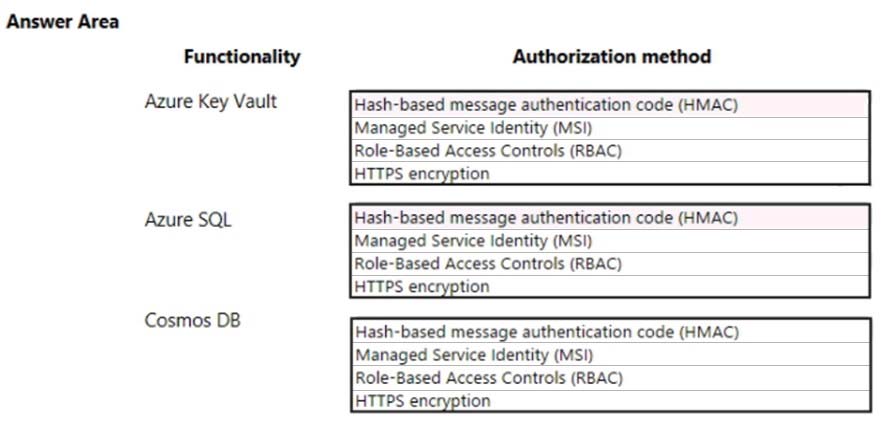
Note: This question is part of series of questions that present the same scenario. Each question in the series contains a unique solution that might meet the stated goals. Some question sets might have more than one correct solution, while others might not have a correct solution.
After you answer a question in this section, you will NOT be able to return to it. As a result, these questions will not appear in the review screen.
You have an Azure subscription that contains a resource group named RG1.
You create an Azure Active Directory (Azure AD) group named ResearchUsers that contains the user accounts of all researchers.
You need to recommend a solution that meets the following requirements:
✑ The researchers must be allowed to create Azure virtual machines.
The researchers must only be able to create Azure virtual machines by using specific Azure Resource Manager templates.
Solution: Create a lab in Azure DevTest Lab. Configure the DevTest Labs settings. Assign the DevTest Labs User role to the ResearchUsers group.
Does this meet the goal?A. Yes
B. No
Note: This question is part of series of questions that present the same scenario. Each question in the series contains a unique solution that might meet the stated goals. Some question sets might have more than one correct solution, while others might not have a correct solution.
After you answer a question in this section, you will NOT be able to return to it. As a result, these questions will not appear in the review screen.
You are designing an Azure solution for a company that wants to move a .NET Core web application from an on-premises data center to Azure. The web application relies on a Microsoft SQL Server 2016 database on Windows Server 2016. The database server will not move to Azure.
A separate networking team is responsible for configuring network permissions.
The company uses Azure ExpressRoute and has an ExpressRoute gateway connected to an Azure virtual network named VNET1.
You need to recommend a solution for deploying the web application.
Solution: Deploy the web application by using an Azure Kubernetes Service (AKS) container on VNET1.
Does this meet the goal?A. Yes
B. No
You develop a new Azure Web App that uses multiple Azure blobs and static content. The Web App uses a large number of JavaScript files and cascading style sheets. Some of these files contain references to other files. Users are geographically dispersed.
You need to minimize the time to load individual pages.
What should you do?A. Migrate the Web App to Azure Service Fabric
B. Use an Azure Content Delivery Network (CDN)
C. Implement an Azure Redis Cache
D. Create a services layer by using an Azure-hosted ASP.NET web API
E. Enable the Always On feature of the Web App
HOTSPOT -
Your company has two on-premises sites in New York and Los Angeles and Azure virtual networks in the East US Azure region and the West US Azure region.
Each on-premises site has Azure ExpressRoute circuits to both regions.
You need to recommend a solution that meets the following requirements:
✑ Outbound traffic to the Internet from workloads hosted on the virtual networks must be routed through the closest available on-premises site.
✑ If an on-premises site fails, traffic from the workloads on the virtual networks to the Internet must reroute automatically to the other site.
What should you include in the recommendation? To answer, select the appropriate options in the answer area.
NOTE: Each correct selection is worth one point.
Hot Area:
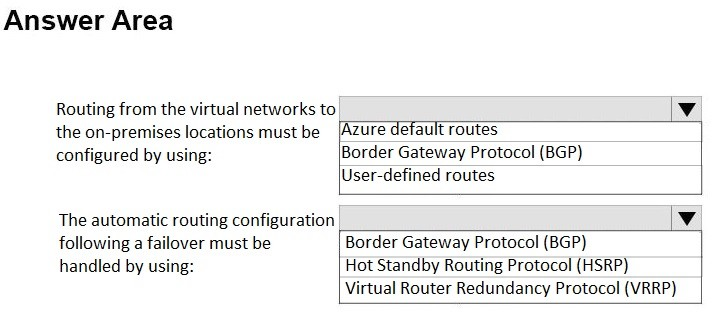
Note: This question is part of series of questions that present the same scenario. Each question in the series contains a unique solution that might meet the stated goals. Some question sets might have more than one correct solution, while others might not have a correct solution.
After you answer a question in this section, you will NOT be able to return to it. As a result, these questions will not appear in the review screen.
A company has custom ASP.NET and Java applications that run old versions of Windows and Linux. The company plans to place applications in containers.
You need to design a solution that includes networking, service discovery, and load balancing for the applications. The solution must support storage orchestration.
Solution: You create an Azure virtual network, public IP address, and load balancer. Then add virtual machines (VMs) to the solution and deploy individual containers on them.
Does the solution meet the goal?A. Yes
B. No
HOTSPOT -
You have 20 Azure virtual machines that run Windows Server 2016 based on a custom virtual machine image. Each virtual machine hosts an instance of a VSS- capable web app that was developed in-house. Each instance is accessed by using a public endpoint. Each instance uses a separate database. The average database size is 200 GB.
You need to design a disaster recovery solution for individual instances. The solution must meet the following requirements:
✑ Provide a recovery time objective (RTO) of six hours
✑ Provide a recovery point objective (RPO) of eight hours
✑ Support recovery to a different Azure region
✑ Support VSS-based backups
✑ Minimize costs
What should you include in the recommendation? To answer, select the appropriate options in the answer area.
NOTE: Each correct selection is worth one point.
Hot Area:
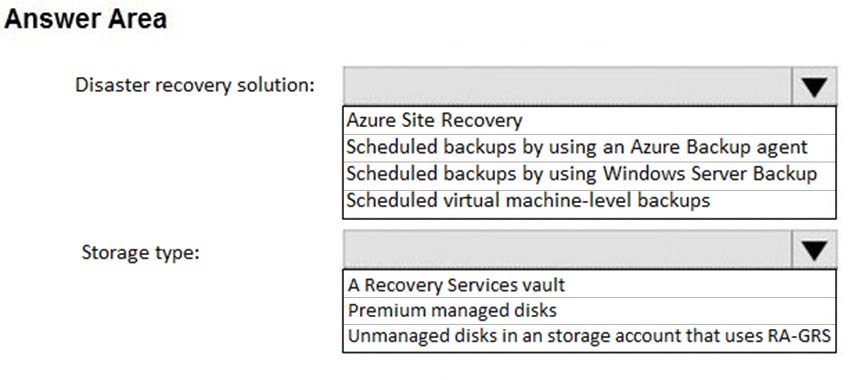
Your network contains an on-premises Active Directory forest named contoso.com. The forest is synced to an Azure Active Directory (Azure AD) tenant named contoso.com and an Azure AD Domain Services (Azure AD DS) domain named contoso-aad.com.
You have an Azure Storage account named Storage1 that contains a file share named Share1.
You configure NTFS permissions on Share1. You plan to deploy a virtual machine that will be used by several users to access Share1.
You need to ensure that the users can access Share1.
Which type virtual machine should you deploy?A. a virtual machine that runs Windows Server 2016 and is joined to the contoso.com domain
B. a virtual machine that runs Windows 10 and is joined to the contoso-add.com domain
C. a virtual machine that runs Windows 10 and is hybrid Azure AD joined to the contoso.com domain
D. an Azure virtual machine that runs Windows Server 2016 and is joined to the contoso-add.com domain
You have an Azure SQL database named DB1 that contains multiple tables.
You need to improve the performance of DB1. The solution must minimize administrative effort.
What should you use?A. Azure Monitor
B. Azure Advisor
C. Query Performance Insight
D. automatic tuning
After you answer a question in this section, you will NOT be able to return to it. As a result, these questions will not appear in the review screen.
You have an on-premises Hyper-V clusters that hosts 20 virtual machines. Some virtual machines run Windows Server 2016 and some run Linux.
You plan to migrate the virtual machines to an Azure subscription.
You need to recommend a solution to replicate the disks of the virtual machines to Azure. The solution must ensure that the virtual machines remain available during the migration of the disks.
Solution: You recommend implementing an Azure Storage account, and then running AzCopy.
Does this meet the goal?A. Yes
B. No
HOTSPOT -
You have a web application that uses a MongoDB database. You plan to migrate the web application to Azure.
You must migrate to Cosmos DB while minimizing code and configuration changes.
You need to design the Cosmos DB configuration.
What should you recommend? To answer, select the appropriate values in the answer area.
NOTE: Each correct selection is worth one point.
Hot Area:
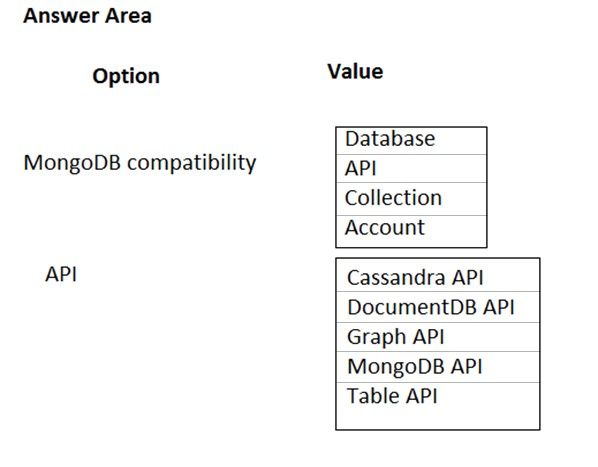
You plan to deploy 200 Microsoft SQL Server databases to Azure by using Azure SQL Database and Azure SQL Database Managed Instance.
You need to recommend a monitoring solution that provides a consistent monitoring approach for all deployments. The solution must meet the following requirements:
✑ Support current-state analysis based on metrics collected near real-time, multiple times per minute, and maintained for up to one hour
✑ Support longer term analysis based on metrics collected multiple times per hour and maintained for up to two weeks.
✑ Support monitoring of the number of concurrent logins and concurrent sessions.
What should you include in the recommendation?A. dynamic management views
B. trace flags
C. Azure Monitor
D. SQL Server Profiler
HOTSPOT -
You have the application architecture shown in the following exhibit.
Use the drop-down menus to select choice that completes each statement based on the information presented in the graphic.
NOTE: Each correct selection is worth one point.
Hot Area:
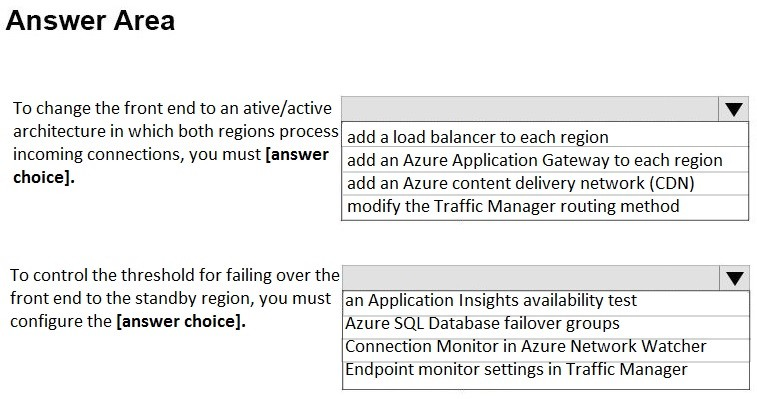
You have 100 servers that run Windows Server 2012 R2 and host Microsoft SQL Server 2012 R2 instances. The instances host databases that have the following characteristics:
✑ The largest database is currently 3 TB. None of the databases will ever exceed 4 TB.
✑ Stored procedures are implemented by using CLR.
You plan to move all the data from SQL Server to Azure.
You need to recommend an Azure service to host the databases. The solution must meet the following requirements:
✑ Whenever possible, minimize management overhead for the migrated databases.
✑ Minimize the number of database changes required to facilitate the migration.
Ensure that users can authenticate by using their Active Directory credentials.
What should you include in the recommendation?A. Azure SQL Database single databases
B. Azure SQL Database Managed Instance
C. Azure SQL Database elastic pools
D. SQL Server 2016 on Azure virtual machines
A company has deployed several applications across Windows and Linux Virtual machines in Azure. Log Analytics are being used to send the required data for alerting purposes for the Virtual Machines.
You need to recommend which tables need to be queried for security related queries.
Which of the following would you query for events from Linux system logging?A. Azure Activity
B. Azure Diagnostics
C. Event
D. Syslog
HOTSPOT -
Your company has an API that returns XML data to internal applications.
You plan to migrate the applications to Azure. You also plan to allow the company's partners to access the API.
You need to recommend an API management solution that meets the following requirements:
✑ Internal applications must receive data in the JSON format once the applications migrate to Azure.
✑ Partner applications must have their header information stripped before the applications receive the data.
What should you include in the recommendation? To answer, select the appropriate options in the answer area.
NOTE: Each correct selection is worth one point.
Hot Area:
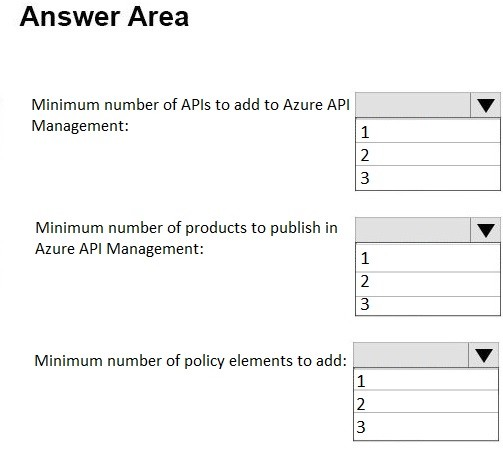
After you answer a question in this section, you will NOT be able to return to it. As a result, these questions will not appear in the review screen.
You have an Azure Storage account that contains two 1-GB data files named File1 and File2. The data files are set to use the archive access tier.
You need to ensure that File1 is accessible immediately when a retrieval request is initiated.
Solution: You move File1 to a new storage account. For File1, you set Access tier to Archive.
Does this meet the goal?A. Yes
B. No
HOTSPOT -
You have an Azure subscription that contains 300 Azure virtual machines that run Windows Server 2016.
You need to centrally monitor all warning events in the System logs of the virtual machines.
What should you include in the solutions? To answer, select the appropriate options in the answer area.
NOTE: Each correct selection is worth one point.
Hot Area:

You have 100 devices that write performance data to Azure Blob storage.
You plan to store and analyze the performance data in an Azure SQL database.
You need to recommend a solution to move the performance data to the SQL database.
What should you include in the recommendation?A. Azure Data Box
B. Azure Data Factory
C. Azure Database Migration Service
D. Data Migration Assistant
You plan to run an image rendering workload in Azure. The workload uses parallel compute processes.
What is the best service to use to run the workload? More than one answer choice may achieve the goal. Select the BEST answer.A. an Azure virtual machine scale set
B. Azure Kubernetes Service (AKS)
C. Azure Batch
D. Azure Container Service
HOTSPOT -
Your organization has developed and deployed several Azure App Service Web and API applications. The applications use Azure Key Vault to store several authentication, storage account, and data encryption keys. Several departments have the following requests to support the applications:
You need to recommend the appropriate Azure service for each department request.
What should you recommend? To answer, configure the appropriate options in the dialog box in the answer area.
NOTE: Each correct selection is worth one point.
Hot Area:
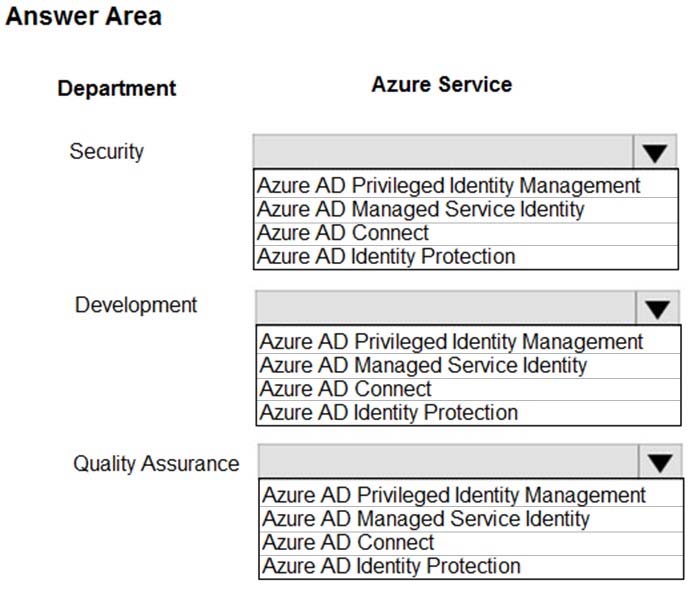
You have a web app named App1 that is hosted on-premises and on four Azure virtual machines. Each virtual machine is in a different region.
You need to recommend a solution to ensure that users will always connect to the closest instance of App1. The solution must prevent the users from attempting to connect to a failed instance of App1.
Which two possible recommendations achieve the goal? Each correct answer presents a complete solution.
NOTE: Each correct selection is worth one point.A. Azure Front Door Service
B. Azure Load Balancer
C. round-robin DNS
D. Azure Traffic Manager
E. Azure Application Gateway
Note: This question is part of series of questions that present the same scenario. Each question in the series contains a unique solution that might meet the stated goals. Some question sets might have more than one correct solution, while others might not have a correct solution.
After you answer a question in this section, you will NOT be able to return to it. As a result, these questions will not appear in the review screen.
You have an Azure subscription that contains a resource group named RG1.
You create an Azure Active Directory (Azure AD) group named ResearchUsers that contains the user accounts of all researchers.
You need to recommend a solution that meets the following requirements:
✑ The researchers must be allowed to create Azure virtual machines.
✑ The researchers must only be able to create Azure virtual machines by using specific Azure Resource Manager templates.
Solution: On RG1, assign the Contributor role to the ResearchUsers group. Create a custom Azure Policy definition and assign the policy to RG1.
Does this meet the goal?A. Yes
B. No
Note: This question is part of series of questions that present the same scenario. Each question in the series contains a unique solution that might meet the stated goals. Some question sets might have more than one correct solution, while others might not have a correct solution.
After you answer a question in this section, you will NOT be able to return to it. As a result, these questions will not appear in the review screen.
You have an Azure subscription named Project1. Only a group named Project1admins is assigned roles in the Project1 subscription. The Project1 subscription contains all the resources for an application named Application1.
Your company is developing a new application named Application2. The members of the Application2 development team belong to an Azure Active Directory
(Azure AD) group named App2Dev.
You identify the following requirements for Application2:
✑ The members of App2Dev must be prevented from changing the role assignments in Azure.
✑ The members of App2Dev must be able to create new Azure resources required by Application2.
✑ All the required role assignments for Application2 will be performed by the members of Project1admins.
You need to recommend a solution for the role assignments of Application2.
Solution: Create a new Azure subscription named Project2. Assign Project1admins the Owner role for the Project2 subscription. Assign App2Dev the Contributor role for the Project2 subscription.
Does this meet the goal?A. Yes
B. No
Your network contains an Active Directory domain named contoso.com that is federated to an Azure Active Directory (Azure AD) tenant. The on-premises domain contains a VPN server named Server1 that runs Windows Server 2016.
You have a single on-premises location that uses an address space of 172.16.0.0/16.
You need to implement two-factor authentication for users who establish VPN connections to Server1.
What should you include in the implementation?A. In Azure AD, create a conditional access policy and a trusted named location
B. Install and configure Azure MFA Server on-premises
C. Configure an Active Directory Federation Services (AD FS) server on-premises
D. In Azure AD, configure the authentication methods. From the multi-factor authentication (MFA) service settings, create a trusted IP range
Note: This question is part of series of questions that present the same scenario. Each question in the series contains a unique solution that might meet the stated goals. Some question sets might have more than one correct solution, while others might not have a correct solution.
After you answer a question in this section, you will NOT be able to return to it. As a result, these questions will not appear in the review screen.
You have an Azure subscription that contains a resource group named RG1.
You create an Azure Active Directory (Azure AD) group named ResearchUsers that contains the user accounts of all researchers.
You need to recommend a solution that meets the following requirements:
✑ The researchers must be allowed to create Azure virtual machines.
✑ The researchers must only be able to create Azure virtual machines by using specific Azure Resource Manager templates.
Solution: On RG1, assign a custom role-based access control (RBAC) role to the ResearchUsers group.
Does this meet the goal?A. Yes
B. No
Note: This question is part of series of questions that present the same scenario. Each question in the series contains a unique solution that might meet the stated goals. Some question sets might have more than one correct solution, while others might not have a correct solution.
After you answer a question in this section, you will NOT be able to return to it. As a result, these questions will not appear in the review screen.
Your company has an on-premises Active Directory Domain Services (AD DS) domain and an established Azure Active Directory (Azure AD) environment.
Your company would like users to be automatically signed in to cloud apps when they are on their corporate desktops that are connected to the corporate network.
You need to enable single sign-on (SSO) for company users.
Solution: Install and configure an Azure AD Connect server to use pass-through authentication and select the Enable single sign-on option.
Does the solution meet the goal?A. Yes
B. No
You are designing a microservices architecture that will support a web application.
The solution must meet the following requirements:
✑ Allow independent upgrades to each microservice
✑ Deploy the solution on-premises and to Azure
✑ Set policies for performing automatic repairs to the microservices
✑ Support low-latency and hyper-scale operations
You need to recommend a technology.
What should you recommend?A. Azure Service Fabric
B. Azure Container Service
C. Azure Container Instance
D. Azure Virtual Machine Scale Set
You have an Azure subscription that contains an Azure Blob storage account named store1.
You have an on-premises file server named Server1 that runs Windows Server 2016. Server1 stores 500 GB of company files.
You need to store a copy of the company files in store1.
Which two possible Azure services achieve this goal? Each correct answer presents a complete solution.
NOTE: Each correct selection is worth one point.A. an Azure Import/Export job
B. an integration account
C. an Azure Batch account
D. Azure data Factory
E. an On-premises data gateway
You have an on-premises network and an Azure subscription. The on-premises network has several branch offices.
A branch office in Toronto contains a virtual machine named VM1 that is configured as a file server. Users access the shared files on VM1 from all the offices.
You need to recommend a solution to ensure that the users can access the shares files as quickly as possible if the Toronto branch office is inaccessible.
What should you include in the recommendation?A. a Recovery Services vault and Azure Backup
B. an Azure file share and Azure File Sync
C. Azure blob containers and Azure File Sync
D. a Recovery Services vault and Windows Server Backup
You use Azure virtual machines to run a custom application that uses an Azure SQL Database instance on the back end.
The IT department at your company recently enabled forced tunneling.
Since the configuration change, developers have noticed degraded performance when they access the database.
You need to recommend a solution to minimize latency when accessing the database. The solution must minimize costs.
What should you include in the recommendation?A. Azure SQL Database Managed Instance
B. virtual network service endpoints
C. Always On availability groups
D. Azure virtual machines that run Microsoft SQL Server servers
HOTSPOT -
You plan to deploy the backup policy shown in the following exhibit.
Use the drop-down menus to select the answer choice that completes each statement based on the information presented in the graphic.
NOTE: Each correct selection is worth one point.
Hot Area:
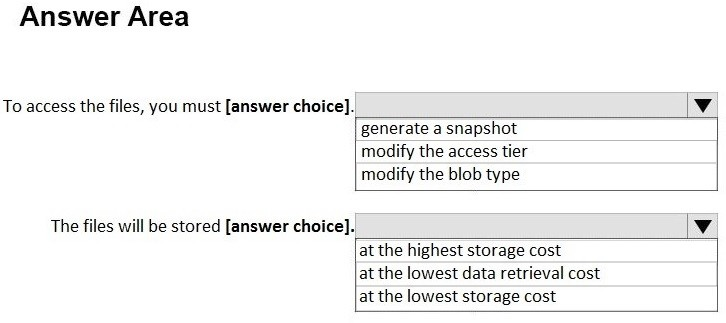
You have Azure virtual machines that run a custom line-of-business web application.
You plan to use a third-party solution to parse event logs from the virtual machines stored in an Azure storage account.
You need to recommend a solution to save the event logs from the virtual machines to the Azure Storage account. The solution must minimize costs and complexity.
What should you include in the recommendation?A. Azure VM Diagnostics Extension
B. Azure Monitor
C. event log subscriptions
D. Azure Log Analytics
Access Full AZ-301 Mock Test Free
Want a full-length mock test experience? Click here to unlock the complete AZ-301 Mock Test Free set and get access to hundreds of additional practice questions covering all key topics.
We regularly update our question sets to stay aligned with the latest exam objectives—so check back often for fresh content!
Start practicing with our AZ-301 mock test free today—and take a major step toward exam success!


